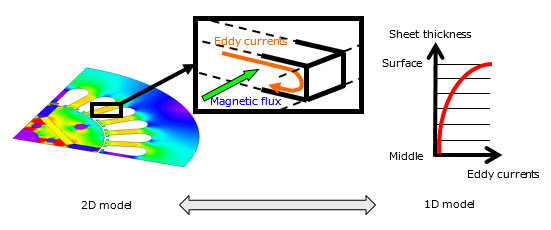Contents
1. Background and subject
2. Approaching these challenges
3. Comparison of losses due to different calculation methods
4. Remaining challenges
5. Summary
6. References
1. Background and subject
As electromagnetic devices become more and more efficient, the precision in iron loss analysis becomes more important for electromagnetic field analysis. Synchronous motors using rare earth permanent magnets are especially suitable for electrical appliances and electric automobiles. To improve the efficiency of these products, measuring iron loss with high precision is needed.
When calculating the eddy current loss in magnetic steel, conventionally, a Fourier transform is taken of the magnetic flux density derived from analysis and compared with actual measurements of the iron loss characteristics to estimate the eddy current loss. However, if the conditions differ from the iron loss characteristic measurements, high precision analysis cannot be carried out. For example, this occurs in cases where the frequency used in the analysis is higher than the upper limit frequency, or when DC is superimposed on AC. The essential thing is to model the steel sheet and solve for the current distribution in the steel sheet using a physical model; however, to faithfully model the steel sheet, the increase in the number of elements results in an impractically large amount of time needed for calculation.
2. Approaching these challenges
To solve the conventional problem, a method of solving the current distribution in the steel sheet using a physical model has been proposed. Solving the magnetic flux density distribution and eddy current distribution in the thickness direction of the steel sheet with the magnetic flux density obtained by two-dimensional (or three-dimensional) magnetic field analysis as the boundary condition is shown in Fig. 2 (below, 1D method [1]). With this method, it is possible to reduce the number of elements and calculation time, as compared with three-dimensional analysis which faithfully models a laminated steel sheet. Since the method uses only physical property values that are not dependent on the excitation state such as the BH curve and the electrical conductivity, independent of the measurement values from which iron loss characteristics can be obtained from a given excitation state, it is possible to deal with an arbitrary driving state.

1D method algorithm
You need to sign in as a Regular JMAG Software User (paid user) or JMAG WEB MEMBER (free membership).
By registering as a JMAG WEB MEMBER, you can browse technical materials and other member-only contents for free.
If you are not registered, click the “Create an Account” button.
Create an Account Sign in



